
Join us for a fascinating look into the greatest symphonies ever composed when composer and conductor Sepehr Pirasteh presents an interactive experience. We encourage attendees to bring their instrument to sightread simple melodies that Sepehr has arranged from different musical eras. Sepehr will conduct participating musicians in an orchestral setting.
Purchase Tickets or Register Current CCM Students
$15 General admission and free for kids 18 and under. To ensure we have room for everyone, please register your kids too.
This lecture will be held at the Harvey Wheeler Community Center at 1276 Main Street, Concord, MA.
CCM Welcomes Vocalist Gray Leiper to our Faculty 
We’re pleased to announce Gray Leiper will join us in January as the voice instructor who will lead Beginner Vocals and Concord Conservatory Girls Chorus in addition to private lessons. He’s a baritone who seeks to bring out the vivid storyteller that exists within all singers through classical, choral, musical, theater, pop, rock, and jazz vocal genres.
Get to know Gray, and you’ll understand how he inspires his students.

Do you long to be a better musician? Open the books and sheet music and study those who came before us. Studying historical pieces and how they evolved, especially those iconic symphonies from masters like Mozart and Stravinsky, teaches us to play better and understand music.
Beyond music education, exploring symphonies of the past provides a comprehensive, intriguing, and periscopic history lesson. As CCM violin faculty member and Music Achievement Program Coordinator Eric Mrugala says, “Symphonies helped influence the trajectory of music history. It gives us a lens into the different cultures, ideas, and values of the composers that wrote them.” 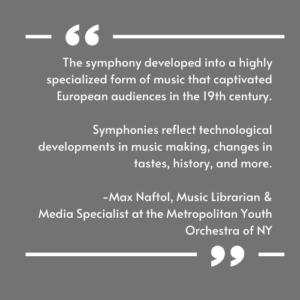
Dared to be different
Delving into classic symphonies from Beethoven: Symphony No.3, ‘Eroica’ to Tchaikovsky: Symphony No.6, ‘Pathetique’ gives us insight into music theory, illuminates innovative practices, and promotes music appreciation. We can understand why Mozart veered from the status quo and used melody to set his works apart from others and why he preferred to have more than one movement throughout his musical compositions. (Britanicca.com)
Studying symphonies gives us valuable information on composers. It provides knowledge about the world around us—what historical or personal events shaped compositions and how composers injected technological advances and their perspectives into music.
Starting with the basics, what is a symphony?
Tom Service explains what a symphony is in The Guardian article, The symphony, and how it changed our world, “It’s usually how we refer to the multi-movement form that evolved in the early 18th century in central Europe (from the Baroque suite and the operatic overture) as a self-contained work of purely instrumental music, and which went on to become the single most prestigious expression of musical architecture in the late 18th, 19th and early 20th centuries, the highpoint of many composers’ ambition and achievement.”
As Max Naftol, Music Librarian & Media Specialist of the Metropolitan Youth Orchestra of New York, says, “The birth of the classical symphony occurred in parallel with the sonata form, which is one of the main reasons audiences grew to love symphonies. The knowledge of the musical form allowed the listener to understand what was happening in the music, even without great knowledge. This has largely been lost since, but the audiences in 19th century Europe would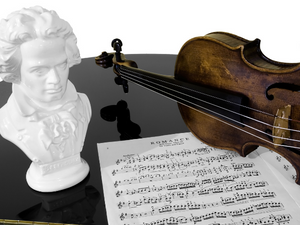 have been aware of at least the major sections of sonata form (exposition, development, and recapitulation), and could follow along using the form itself as a guide. This also allowed composers to play with these established expectations more directly, manipulating and subverting them for numerous effects. Beethoven famously took this further than any of his contemporaries, with furious recapitulations almost acting as a second development section, confusing and bewildering listeners, and helping usher in the Romantic period of music.”
have been aware of at least the major sections of sonata form (exposition, development, and recapitulation), and could follow along using the form itself as a guide. This also allowed composers to play with these established expectations more directly, manipulating and subverting them for numerous effects. Beethoven famously took this further than any of his contemporaries, with furious recapitulations almost acting as a second development section, confusing and bewildering listeners, and helping usher in the Romantic period of music.”
Studying music theory and symphonies goes hand-in-hand, helping us understand the language and structure of music.
As Max explains, “The history of the symphony is also one of technological innovation, such as the introduction or exclusion of new instruments. Like Berlioz, more adventurous and liberal composers wrote for giant orchestras replete with all the new instruments he could get his hands on. Many of these instruments never made it big, but they’re still called for in Symphonie Fantastique (like the ophicleide). Others were reticent to allow entry to instrumental latecomers, such as the saxophone, which is why classical symphonies don’t include this powerful instrument. It would take years before adventurous composers, such as the American George Gershwin, influenced by Jazz, would include the saxophone in a symphonic orchestra setting.”
Learning from the masters
Anyone who listens to classical music would surely agree that studying symphonies can instill and encourage a lifelong love of music. Beautiful and powerful pieces, such as Brahms’ Symphony No. 4, help spur creativity. As you listen to his No. 4, you can picture him writing this iconic piece as he worked secretly in a quiet Austrian town in the Alps. Considered a traditionalist who favored structure, Brahms unveiled his innovative side as well, which inspired many composers who followed after him.
Studying Mozart’s Symphony No 40 reveals how composers evoke certain emotions with their music. What do you think Mozart would say about why this composition veered from others? It was written in a minor key to exude a more melancholy tone than his usual exuberant works.
Explore the symphonic genre
CCM presents the lecture, Symphonic Exploration, on Friday, December 10 from 7:00 – 8:00 pm presented by Sepehr Pirasteh.
Explore the depths of some of the greatest symphonies ever composed, and how the symphony evolved from the 18th century to the 20th century.
A native of Shiraz, Iran, composer, and conductor Sepehr Prasteh draws on Persian classical and folk music and contemporary classical music to express his concerns and fears about the political and social realities of the world we live in. As a conductor, he focused on premiering new music written by young and emerging composers and conducting the classical repertoire.
For details on this event and ticket information>>
This lecture will be held at the Harvey Wheeler Community Center at 1276 Main Street, Concord, MA.
 The question above has a couple of different answers. First and foremost, rhythm is necessary just to get you through your day. Without it, you wouldn’t be able to walk or chew gum, let alone do both at the same time. You wouldn’t even be able to breathe. Because rhythm, it turns out, is vital to our very survival. In the words of one study, “The cerebellar output is rhythmically modulated and provides phasic drive to the fast-descending pathways.”
The question above has a couple of different answers. First and foremost, rhythm is necessary just to get you through your day. Without it, you wouldn’t be able to walk or chew gum, let alone do both at the same time. You wouldn’t even be able to breathe. Because rhythm, it turns out, is vital to our very survival. In the words of one study, “The cerebellar output is rhythmically modulated and provides phasic drive to the fast-descending pathways.”
Or, as Bjork put it, “The mind and body can’t help getting in sync.”
Sync and Swim 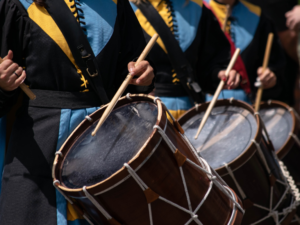
OK. So the connection that allows your body to magically do what your brain commands is one type of rhythm. But for a musician, rhythm has a more specific definition — even if it remains frustratingly abstract. It is not, for example, just a matter of “keeping the beat” — although beat is certainly a big part of it. But rhythm is also the pauses in between the beats, and the pattern of beats and pauses that emerges over a given time. “Think of the beat as the music’s skeleton,” Steve Benedetto writes in Making Music Mag.com. It is “the pace, tempo or the timing that it takes to play a particular piece of music.”
Rhythm, on the other hand, “can be thought of as how you inhabit the beat. … In essence, a music piece’s beat is its unchanging tempo, while the rhythm is a pattern in which a piece’s notes flow.”
Noteworthy Differences
While it’s possible for a group of gifted musicians to intuitively grasp a piece’s rhythmic flow, most performers need guidance. Think of those rhythmic notations on a piece of sheet music — the time signatures, the rests, and the different durations of notes — as a kind of musical GPS that helps keep the performers on course so they all end up in the same place. “Without rhythm, most of the music we hear and love would sound disjointed, aimless, and impossible to follow,” songwriter Patrick McGuire notes on Musika.
Understanding notations in order to play in rhythm is one of the primary reasons that budding musicians should learn to read music. The most common rhythmic notation is the time signature, and the most common time signature is 4/4.
What does “4/4” mean? The top “4” signifies that there are four beats per measure, while the bottom “4” signifies that there are four quarter notes in that measure. Note values commonly range from whole notes to sixteenth notes, although some composers use even smaller values, including the remarkable 1024th notes in Toccata Grande Cromatica by Anthony Philip Heinrich. Not only is it a challenge to try to play 1024th notes, it’s hard to even get the notations to fit within the measure.
Speaking of which: What exactly is a measure? “A measure in music is simply the short sections or boxes of musical notes we see in music notation,” McGuire writes. “On pitched instruments, rhythm notation will be written on various lines on the staff. Musicians playing non-pitched instruments read notes from a singular line of music because they don’t need to bother with reading different lines for different pitches.”
Rests, as the name suggests, indicate when a performer should stay silent and for how long. Rest durations are expressed in the same way as note durations: whole, half, quarter, etc.
Taken together, time signatures, notes, rests, and other rhythmic notations create a sort of recipe that tells you how the piece should be played.
That’s the Theory — What About the Practice?
As in every other aspect of musicianship, practice in rhythm reading makes perfect (or at least proficient). Start with the basics. Clapping exercises, for example, are an especially good way to make the concept of rhythm comprehensible to kids.
Another classic way to convey rhythm is to use a metronome. If your meter isn’t exact — and it probably isn’t — a 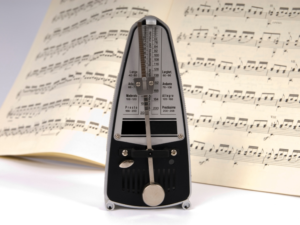 metronome will keep you in time. Precision counts, and even experienced musicians find that a metronome helps keep them in time as they practice.
metronome will keep you in time. Precision counts, and even experienced musicians find that a metronome helps keep them in time as they practice.
Other methods for staying in rhythm include counting out loud, although McGuire acknowledges that “a lot of people might feel silly doing this.” (For an example of why counting out loud can be both effective and silly, listen to Lawrence Welk’s “A-One A-Two A-Cha Cha Cha.”)
Overcoming self-consciousness is a big part of learning to play in rhythm — and to play like a true musician. As McGuire notes, “Real musicians consistently mark their sheet music with a pencil to help them be able to read and understand tough passages of rhythm.”
The goal is to avoid the ultimate self-consciousness: to be out of rhythm with everyone else. And the best way to ensure that never happens is to practice, practice, practice. Stick with those rhythm exercises, and you’ll find that, as Bjork said, “The mind and body can’t help getting in sync.”
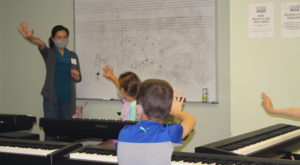
“I didn’t choose this path,” says CCM piano instructor Kitty Cheung-Evans. “Music chose me to be on this path.”
What a winding path it has been. Tim and Stella Cheung envisioned wonderful opportunities for their family when they emigrated from Hong Kong to Smithers, British Columbia a little more than 30 years ago. “My parents really wanted me to get a college degree,” Kitty says. “That was their dream.”
Kitty’s dream was a bit different. “I was really into baking when I was a teenager,” she says. “So I threatened to go to Paris and become a pastry chef.”
Paris and become a pastry chef.”
Her parents persuaded her to get her high school diploma first. When she did that, they prevailed upon her to at least give college a try, since the pastry thing seemed, well, half-baked.
“The only other thing I knew how to do was play piano,” Kitty says. “I’d been doing that since I was a kid.” So she dedicated herself to her instrument, eventually receiving a Bachelor’s in Piano Performance from the University of Lethbridge and a Master’s in Piano Performance from the Longy School of Music in Cambridge, Massachusetts. She also completed an intensive yearlong piano performance study at the Royal Conservatory’s Glenn Gould School in Toronto.
“My parents were thrilled,” Kitty says. “I was the first person in the family to get a master’s degree.”
There was just one problem. “After I graduated I wasn’t sure if I wanted to spend the rest of my life as a performer,” Kitty says, laughing. “Isn’t that great?”
Performing a Valuable Service
As it turned out — yes, it was great. The performing arts’ loss was CCM’s gain. Perhaps in part because of her own struggles to find her path, Kitty has developed a keen sense of empathy with her students, particularly those who lack a sense of direction. She appreciates the collaborative atmosphere at CCM, often comparing notes with other instructors on ways to better connect students with one another.
“Playing piano can be a very lonely activity,” Kitty says. “Some kids love to play in class but don’t want to practice. I was one of those kids. I didn’t really enjoy practicing until I was maybe 14 years old.”
The key to connecting with students, Kitty says, is to treat them as individuals rather than apply a one-size-fits-all approach. “I try to forget about the student’s age and forget that I am the ‘authority’ and just listen,” she says. “Once we connect as two people, then it becomes: ‘What are we going to discover today about music?’ And it’s amazing to hear what they have to say.”
Connecting the Dots 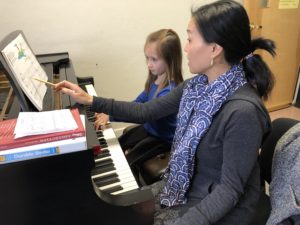
Reading music can be a particular challenge, especially with her youngest students. “For many kids, a piece of sheet music is just a lot of black and white symbols,” Kitty says. “The first thing they often say to me is, ‘Miss Kitty, this is impossible.”
To help penetrate the seemingly impenetrable, Kitty shares biographical details about the composers. “I talk about what they were like when they were younger, where they grew up, what kind of living conditions they had, what their personalities were like,” Kitty says. “That way I can help students to interpret the symbols on the sheet music as a kind of story.”
Along the same line, Kitty also draws parallels between music compositions and other forms of art, such as paintings and sculptures. “I studied art history as an undergraduate course,” she says, noting that visual arts and music are related but different in important ways. “Music is more of a neurological response, while visual art stimulates a different part of your brain and brings out different emotions.”
Still, she sees similarities between a musician sitting down at an instrument and playing by ear and a sculptor working with raw clay; both activities help develop important skills like intuition and improvisation. The goal is to teach kids that learning music isn’t a matter of following rote instructions — it’s about learning different interpretations.
And whenever a student has a breakthrough, it’s a magic moment. That recently happened with one of Kitty’s youngest students, who was just 5½. “He came in, immediately sat down at the bench, and said, ‘Miss Kitty, I have found a new pattern to this song. Would you like me to show you?’ Making those discoveries together is the most wonderful thing that can happen in the studio.”
The Fantasy Is Baked In 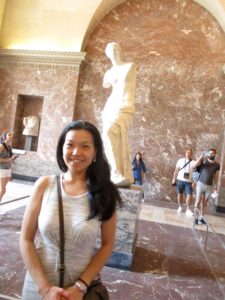
In the end, Kitty appears to have found the perfect payoff for all those years of practice and study, for all the work she poured into receiving her master’s degree. But she’ll always have Paris and that unfulfilled adolescent fantasy — one that she confesses has never entirely left her. In fact, after visiting Paris twice, she says that the attraction might be stronger than ever.
“I see Paris as two very different cities,” Kitty says. The first time she visited, as a teenager, she took full advantage of the abundant nightlife and vibrant social scene.
“The second time, I went with my husband,” says Kitty, who is married to CCM music theory instructor Peter Evans. “And I found that Paris truly is the city of love.”
She laughs. “Can we just stop there?”
In this case, no further interpretation is necessary.
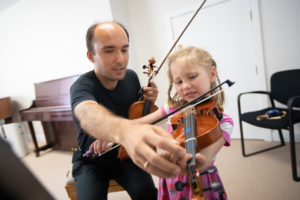
Throughout these past 18 months, our community has amazed and inspired students and faculty at Concord Conservatory of Music. YOU created a true sense of belonging as this “new normal” began to become commonplace. Music has evolved into a uniting force for all of us.
Throughout last year, thanks to the help of friends like you, Concord Conservatory of Music presented the arts as a vital part of the tapestry of our community. We welcomed many new faces to experience and appreciate not just the music, but the joy of creating it!
This year, your support will bring focus to a priority that has emerged because of the pandemic—the need to ease the learning and social loss experienced by our children.
Music is a universal language. Musical training strengthens children’s brains, boosts engagement of the brain networks, develops fine motor skills, and awakens young minds for building future skillsets. Your support will inspire, energize, and untap their music potential within a fun community-building program!
On behalf of our students, their families, and all in our communities who experience the music, thank you.